Ozito PXOFCS-636 Handleiding
Ozito
Compressor
PXOFCS-636
Bekijk gratis de handleiding van Ozito PXOFCS-636 (2 pagina’s), behorend tot de categorie Compressor. Deze gids werd als nuttig beoordeeld door 69 mensen en kreeg gemiddeld 5.0 sterren uit 35 reviews. Heb je een vraag over Ozito PXOFCS-636 of wil je andere gebruikers van dit product iets vragen? Stel een vraag
Pagina 1/2

STANDARD EQUIPMENT
0
25
50
75
100
125
150
0
(1)00
(3)00 (5)00(7)00
(9)00
2
4 6 8
10
Lb /in²(PSI)kPA(BAR)
PRESSURE GAUGE
kg/cm²
-
+
0
25
5
0
75
100
12 5
150
0
(1)00(3)00(5)00(7)00(9)00
246 810
Lb/in²(PSI)kPA(BAR)
PRESSURE GAUGEkg/cm²
-
+
PXOFCS-636
INSTRUCTION MANUAL
SPECIFICATIONS
Input: 2 x 18V
No Load Speed: 3,200/min
Tank Volume: 6L
Max. Air Delivery: 130L/min
Free Air Delivery: 58.6L/min
Max. Working Pressure: 116psi / 8bar (0.8MPa)
Working Temperature: 5 to 40°C
IP Rating: IPX0
Weight: 11.51kg
ozito.com.au
1122
GENERAL POWER TOOL SAFETY WARNINGS
AIR COMPRESSOR SAFETY WARNINGS
WARNING! In the event that an air line is cut or broken, the air supply must be turned off at the
compressor. A broken air line which is not supported is extremely dangerous and can whip around
very quickly, both with the capability of striking people, and blowing foreign particles into the air.
Do not attempt to catch the air line but immediately keep bystanders well clear and turn off the
air supply to the hose, turn off the compressor at the On / Off button, and then remove the hose
from the compressor.
The appliance may not be suitable for use in environments having a warm damp equable climate.
If the compressor repeatedly shuts off due to thermal overload protection, stop using the
compressor and wait until the environment has sufficiently cooled before resuming use.
• To reduce the risk of fire or explosion, never spray flammable liquids in a confined area. If
sparks come into contact with petrol vapours or solvents, they may ignite the vapours and
cause a fire or explosion.
• Keep the compressor at least 300mm from the nearest wall to ensure adequate ventilation for
cooling purposes. Always operate the compressor in a well ventilated area.
• Never directly inhale the compressed air produced by a compressor and do not use it for
charging breathing tanks.
• The compressed air produced by the compressor cannot not be used for pharmaceutical, food
or medical purposes or to fill the air bottles of scuba divers.
• Do not use welding equipment in close proximity to the compressor. Do not weld anything to the
air tank of the compressor: this could dangerously weaken the tank and will void the warranty.
• Do not use the compressor outdoors when it is raining or on a wet surface; either situation
could cause an electric shock.
• Never let the compressor come into contact with water or other liquids, as the appliance is live,
this could cause electrocution or short-circuits. Never use the appliance with bare feet, wet
hands or wet feet.
• Always maintain a safety distance of at least 3 meters between the compressor and the work
area. Ensure that the compressor is on a stable surface.
• Always use the handle to move the compressor.
• Do not cover the air inlets on the compressor. Do not attempt to block the air outlet with your
finger or any part of your body.
• Compressors and lines reach high temperatures during operation. Avoid contact! Risk of burns!
• Gases or vapours drawn in by the compressor have to be kept free of constituents that may
cause fire or explosions inside the compressor.
• Do not attempt to adjust/modify the safety valve in any way. The safety valve installed on this
air compressor is designed to automatically release pressure in case of excess pressure build
up in the tank.
• When you disconnect the hose coupling, hold the coupling element in your hand to prevent
injury from the whiplashing hose. Protect the air hose from damage. Inspect for weak or worn
spots regularly and replace if necessary.
• Wear hearing, eye and breathing protection. Never point the nozzle of an accessory towards
any part of your body or towards another person. Never use it to clean clothes that are still
being worn.
• Always switch off the compressor before removing the batteries.
• After using the compressor, switch off the on/off button, disconnect the power supply and use
a blow gun or similar to release the remaining pressure in the tank. Do not attempt to remove
any part of the machine whilst it is under pressure. Drain the moisture from the tank after use.
It will help prevent corrosion.
• Check the maximum pressure rating of any tools or accessories that you intend using with the
compressor. The output pressure of the air from the compressor must be regulated so that it
never exceeds the rated pressure of the tool or accessory.
• The tool must be used only for its prescribed purpose. Any use other than those mentioned in
this manual will be considered a case of misuse. The user and not the manufacturer shall be
liable for any damage or injury resulting from such cases of misuse. The manufacturer shall not
be liable for any changes made to the tool nor for any damage resulting from such changes.
• Even when the tool is used as prescribed it is not possible to eliminate all residual risk factors.
The following hazards may arise in connection with the tool’s construction and design:
- Damage to the lungs if an effective breathing mask is not worn.
- Damage to hearing if effective earmuffs are not worn.
- Damage to the eyes if effective safety goggles or shield are not worn.
• Avoid using power tools for long periods of time without breaks. Vibration from tools can be
transmitted into your hands and arms.
Cordless Oil Free Air
Compressor
Air Hose, Air Filter, Tyre
Pressure Gun & Long Needle
Nozzle
Nozzle Base & 7 x Ination
Nozzles
MAINTENANCE
OIL FREE AIR
COMPRESSOR
IN ORDER TO MAKE A CLAIM UNDER THIS WARRANTY YOU
MUST RETURN THE PRODUCT TO YOUR NEAREST BUNNINGS
WAREHOUSE WITH YOUR BUNNINGS REGISTER RECEIPT. PRIOR TO
RETURNING YOUR PRODUCT FOR WARRANTY PLEASE TELEPHONE
OUR CUSTOMER SERVICE HELPLINE:
Australia 1800 069 486
New Zealand 0508 069 486
WARRANTY
TO ENSURE A SPEEDY RESPONSE PLEASE HAVE THE MODEL
NUMBER AND DATE OF PURCHASE AVAILABLE. A CUSTOMER
SERVICE REPRESENTATIVE WILL TAKE YOUR CALL AND
ANSWER ANY QUESTIONS YOU MAY HAVE RELATING TO THE
WARRANTY POLICY OR PROCEDURE.
OZITO INDUSTRIES PTY. LTD. 25 Fox Drive, Dandenong South, VIC 3175, Australia.
The benets provided under this warranty are in addition to other rights and
remedies which are available to you at law.
Our goods come with guarantees that cannot be excluded at law. You are entitled to
a replacement or refund for a major failure and for compensation for any other
reasonably foreseeable loss or damage. You are also entitled to have the goods
repaired or replaced if the goods fail to be of acceptable quality and the failure
does not amount to a major failure.
Generally you will be responsible for all costs associated with a claim under this
warranty, however, where you have suffered any additional direct loss as a result of
a defective product you may be able to claim such expenses by contacting our
customer service helpline above.
WARNING
The following actions will result in the warranty being
void.
• If the tool has been operated on a supply voltage other than that specied
on the tool.
• If the tool shows signs of damage or defects caused by or resulting from
abuse, accidents or alterations.
• Failure to perform maintenance as set out within the instruction manual.
• If the tool is disassembled or tampered with in any way.
5 YEAR REPLACEMENT WARRANTY
Your Product is guaranteed for a period of 60 months from the original date of
purchase and is intended for DIY (Do It Yourself) use only. If a product is defective it
will be replaced in accordance with the terms of this warranty. Lithium Ion
batteries and chargers are covered by a 36 month
warranty and are excluded from the warranty extension. Warranty excludes
consumable parts.
6. TROUBLESHOOTING
WARNING! BEFORE CLEANING OR CARRYING OUT
ANY MAINTENANCE PROCEDURE, ENSURE THAT
THE BATTERIES HAVE BEEN REMOVED.
Cleaning
• Keep the ventilation slots of the tool clean at all times to ensure efcient
operation.
• After each use, blow air through the tool housing to ensure it is free from
all dust, dirt, etc. Build up of dust or dirt particles may cause the tool to
overheat and shorten the life of the tool.
• If the housing of the tool requires cleaning, do not use solvents. Use of a
cloth only is recommended.
• Never allow any liquid to get inside the tool, never immerse any part of
the tool into liquid.
Storage
Switch off the compressor, remove the batteries, and ventilate the
appliance and all connected pneumatic tools. Drain the pressure tank.
Make sure that it is secured in such a way that it cannot be started up again
by any unauthorised person.
Store the tool in a dry location which is not accessible to unauthorised
persons.
Note: Ozito Industries will not be responsible for any damage or
injuries caused by repair of the tool by an unauthorised person or by
mishandling.
WARNING! Read all safety warnings, instructions, illustrations and specifications provided with
this power tool. Failure to follow all instructions listed below may result in electric shock, fire and/
or serious injury.
Save all warnings and instructions for future reference.
The term “power tool” in the warnings refers to your mains-operated (corded) power tool or battery-operated
(cordless) power tool.
1) Work area safety
a) Keep work area clean and well lit. Cluttered or dark areas invite accidents.
b) Do not operate power tools in explosive atmospheres, such as in the presence of flammable liquids,
gases or dust. Power tools create sparks which may ignite the dust or fumes.
c) Keep children and bystanders away while operating a power tool. Distractions can cause you to lose
control.
2) Electrical safety
a) Power tool plugs must match the outlet. Never modify the plug in any way. Do not use any adapter
plugs with earthed (grounded) power tools. Unmodified plugs and matching outlets will reduce risk of
electric shock.
b) Avoid body contact with earthed or grounded surfaces, such as pipes, radiators, ranges and
refrigerators. There is an increased risk of electric shock if your body is earthed or grounded.
c) Do not expose power tools to rain or wet conditions. Water entering a power tool will increase the risk
of electric shock.
d) Do not abuse the cord. Never use the cord for carrying, pulling or unplugging the power tool. Keep
cord away from heat, oil, sharp edges or moving parts. Damaged or entangled cords increase the risk
of electric shock.
e) When operating a power tool outdoors, use an extension cord suitable for outdoor use. Use of a cord
suitable for outdoor use reduces the risk of electric shock.
f) If operating a power tool in a damp location is unavoidable, use a residual current device (RCD)
protected supply. Use of an RCD reduces the risk of electric shock.
3) Personal safety
a) Stay alert, watch what you are doing and use common sense when operating a power tool. Do not use
a power tool while you are tired or under the influence of drugs, alcohol or medication. A moment of
inattention while operating power tools may result in serious personal injury.
b) Use personal protective equipment. Always wear eye protection. Protective equipment such as a dust
mask, non-skid safety shoes, hard hat or hearing protection used for appropriate conditions will reduce
personal injuries.
c) Prevent unintentional starting. Ensure the switch is in the off-position before connecting to power
source and/or battery pack, picking up or carrying the tool. Carrying power tools with your finger on
the switch or energising power tools that have the switch on invites accidents.
d) Remove any adjusting key or wrench before turning the power tool on. A wrench or a key left attached
to a rotating part of the power tool may result in personal injury.
e) Do not overreach. Keep proper footing and balance at all times. This enables better control of the
power tool in unexpected situations.
f) Dress properly. Do not wear loose clothing or jewellery. Keep your hair and clothing away from moving
parts. Loose clothes, jewellery or long hair can be caught in moving parts.
g) If devices are provided for the connection of dust extraction and collection facilities, ensure these are
connected and properly used. Use of dust collection can reduce dust-related hazards.
h) Do not let familiarity gained from frequent use of tools allow you to become complacent and ignore
tool safety principles. A careless action can cause severe injury within a fraction of a second.
4) Power tool use and care
a) Do not force the power tool. Use the correct power tool for your application. The correct power tool
will do the job better and safer at the rate for which it was designed.
b) Do not use the power tool if the switch does not turn it on and off. Any power tool that cannot be
controlled with the switch is dangerous and must be repaired.
c) Disconnect the plug from the power source and/or remove the battery pack, if detachable, from
the power tool before making any adjustments, changing accessories, or storing power tools. Such
preventive safety measures reduce the risk of starting the power tool accidentally.
d) Store idle power tools out of the reach of children and do not allow persons unfamiliar with the
power tool or these instructions to operate the power tool. Power tools are dangerous in the hands of
untrained users.
e) Maintain power tools and accessories. Check for misalignment or binding of moving parts, breakage
of parts and any other condition that may affect the power tool’s operation. If damaged, have the
power tool repaired before use. Many accidents are caused by poorly maintained power tools.
f) Keep cutting tools sharp and clean. Properly maintained cutting tools with sharp cutting edges are less
likely to bind and are easier to control.
g) Use the power tool, accessories and tool bits etc. in accordance with these instructions, taking into
account the working conditions and the work to be performed. Use of the power tool for operations
different from those intended could result in a hazardous situation.
h) Keep handles and grasping surfaces dry, clean and free from oil and grease. Slippery handles and
grasping surfaces do not allow for safe handling and control of the tool in unexpected situations.
5) Battery tool use and care
a) Recharge only with the charger specified by the manufactur er. A charger that is suitable for one type of
battery pack may create a risk of fire when used with another battery pack.
b) Use power tools only with specifically designated battery packs. Use of any other battery packs may
create a risk of injury and fire.
c) When battery pack is not in use, keep it away from other metal objects, like paper clips, coins, keys,
nails, screws or other small metal objects, that can make a connection from one terminal to another.
Shorting the battery terminals together may cause burns or a fire.
d) Under abusive conditions, liquid may be ejected from the battery; avoid contact. If contact accidentally
occurs, flush with water. If liquid contacts eyes, additionally seek medical help. Liquid ejected from the
battery may cause irritation or burns.
e) Do not use a battery pack or tool that is damaged or modified. Damaged or modified batteries may
exhibit unpredictable behaviour resulting in fire, explosion or risk of injury.
f) Do not expose a battery pack or tool to fire or excessive temperature. Exposure to fire or temperature
above 130 °C may cause explosion.
g) Follow all charging instructions and do not charge the battery pack or tool outside the temperature
range specified in the instructions. Charging improperly or at temperatures outside the specified range
may damage the battery and increase the risk of fire.
6) Service
a) Have your power tool serviced by a qualified repair person using only identical replacement parts. This
will ensure that the safety of the power tool is maintained.
b) Never service damaged battery packs. Service of battery packs should only be performed by the
manufacturer or authorized service providers.
ELECTRICAL SAFETY
WARNING! When using electric tools basic safety precautions should always be followed to
reduce the risk of fire, electric shock and personal injury.
• Read the whole manual carefully and make sure you know how to switch the tool of f in
an emergency, before operating the tool. Save these instructions and other documents supplied
with this tool for future reference.
• This appliance is not intended for use by persons (including children) with reduced physical,
sensory or mental capabilities, or lack of experience and knowledge, unless they have been
given supervision or instruction concerning use of the appliance by a person responsible for
their safety. Children should be supervised to ensure that they do not play with the appliance.
• This appliance is compatible and only to be used with all batteries & chargers from the Ozito
PXC range. Refer to the PXC battery and charger manuals for information regarding charging,
use and storage.
• Always remove the battery from the tool: WARNING!
- when the batteries are to be charged,
- when the tool is left unattended,
- when the tool is being checked, cleaned, or having maintenance work done,
- when the tool is to be stored,
- or if the tool vibrates abnormally.
• Do not combine different types of batteries or new and used batteries.
• Do not use modified or damaged batteries.
DESCRIPTION OF SYMBOLS
Litres per minute Degrees Celsius
No ingress protection against
water Sound power level
Warning
Regulatory Compliance Mark
(RCM)
Decibel rating
Warning! The equipment is
remote-controlled and may
start up without warning
Do not open the outlet before
the air hose is attached
Beware of hot partsDo not expose to rain
Beware of electrical voltage
Wear eye, ear & breathing
protection
VVolts
psi
Direct Current
MPa
L
°C
/min
IPX0
dB
L/min
Megapascals Pounds per square inch
LitresRevolutions per minute
Read Instruction Manual
LWA
Power tools that are no longer usable should not be disposed
of with household waste but in an environmentally friendly
way. Please recycle where facilities exist. Check with your local
council authority for recycling advice.
Recycling packaging reduces the need for landll and raw
materials. Reuse of recycled material decreases pollution in the
environment. Please recycle packaging where facilities exist.
Check with your local council authority for recycling advice.
CARING FOR THE ENVIRONMENT
SPARE PARTS
Spare parts can be ordered from the Special Orders
Desk at your local Bunnings Warehouse.
For further information, or any parts not listed here,
visit www.ozito.com.au or contact Ozito Customer
Service:
Australia 1800 069 486
New Zealand 0508 069 486
E-mail: enquiries@ozito.com.au
Draining The Pressure Tank
WARNING! ALWAYS MAKE SURE THE COMPRESSOR
IS TURNED OFF AND THE TANK PRESSURE GAUGE
SHOWS 0 PSI BEFORE OPENING THE DRAIN
VALVE. TAKE CARE WHEN DISCHARGING AIR
THROUGH THE DRAIN VALVE OR AIR OUTLETS. THE
DISCHARGED AIR CAN CAUSE DUST, STONES, OR
ANY OTHER FOREIGN PARTICLES TO BE BLOWN
THROUGH THE AIR AT HIGH PRESSURE.
Air in the compressor tank causes water to accumulate. This must be
drained off frequently to prevent corrosion and damage to the unit. This
should be performed after each use and prior to the
next use.
1. Turn the drain valve lever anti-
clockwise to open it.
2. Allow all of the water in the tank to drain out.
3. Flip the drain valve lever back up to close it.
Note: The tank will not pressurise while the
drain valve is open.
Cleaning The Air Filters
The air lters prevent dust and dirt being drawn in. It is essential to clean
these lters at least after every 100 hours in service. Clogged air lters will
decrease the performance of the compressor drastically.
1. Allow the compressor to run and build up pressurised air in the tank.
Once the motor has stopped running, turn the compressor off and remove
the batteries.
2. With an air hose and blow gun connected to the regulated pressure
outlet, turn the pressure regulator until the regulated pressure gauge
shows a pressure of around 3bar.
3. Unscrew the air lter.
4. Unscrew the lter housing base and
remove the foam lter from the lter
housing. Tap it and spray it with the
blow gun to remove any dirt.
5. Reinsert the foam lter and
re-assembled the lter unit, then re-
attach the air lter to the compressor. a. a.
b.
FILTER HOUSING
FOAM FILTER
FILTER HOUSING BASE
Symptom Possible Cause Suggested Solution
The compressor does
not start
Compressor has
reached cut-out
pressure
Compressor will
automatically start once
below the cut-in pressure
No power supply Check battery capacity
indicators. Recharge
batteries if they are at.
Outside temperature is
too low
Never operate with an
outside temperature of
below 5°C
Motor is overheated Allow the motor to cool
down. If necessary, remedy
the cause of the overheating
The compressor starts
but there is no pressure
The seals are damaged Check the seals and have
any damaged seals replaced
by a service centre
The drainage valve
leaks
Ensure it is properly closed
The compressor starts,
pressure is shown on
the pressure gauge,
but no pressure to the
air tool
Loose hose
connections
Check the compressed air
hose and tools and replace if
necessary
Leak in a quick-lock
coupling
Check the quick-lock
coupling and replace if
necessary
Insufcient pressure
set on the pressure
regulator
Open the pressure regulator
further

ONLINE MANUAL
Scan this QR Code with your
mobile device to take you to
the online manual.
0
25
50
75
125
0
(1)00
(3)00 (5)00
2
4
kPA(BAR)
PRESSURE G
kg/cm
-
+
Attaching Air Tools
The compressor is intended to be used for pneumatic tools with low air
consumption, such as tyre pump nozzles, blower nozzles, small staple and
nail guns. The compressor is not suitable for tools with a high, continuous
air consumption, such as grinders, impact wrenches and paint guns.
1. The tyre pressure gun can be
used for most bicycle and car tyre
valves.
2. A range of different nozzles has
also been supplied to suit most
common ination valves.
Depress the clip on the
pressure gun hose and
insert the desired nozzle.
3. For the larger nozzles,
attach the nozzle base to
the hose and then screw
on the required nozzle.
4. The pressure gun hose can also be removed and swapped with the long
needle nozzle.
Installing The Battery Packs
1. Lift the battery cover.
2. Slide the batteries into the
battery slots until they click into
place.
WARNING! ALWAYS USE BATTERIES WITH THE
SAME OUTPUT AND THE SAME AMOUNT OF
CHARGE.
2. To remove the batteries, hold
down the battery release button
and then slide the battery out.
Pre-Setup Checks
• Examine the machine for signs of transit damage. If damaged, do not
use, return to place of purchase
• The compressor should be set up near to the user.
• Avoid long air lines and long supply lines (extensions).
• Make sure the intake air is dry and dust-free.
• Do not set up the compressor in damp or wet rooms. The compressor
is designed to be used in dry rooms. It is prohibited to use the
compressor in areas where work is conducted with sprayed water.
• Before you use the machine, make sure that the mains voltage
complies with the specications on the rating plate.
• The compressor may only be used in suitable areas (with good
ventilation and an ambient temperature from 5°C to 40°C). There must
be no dust, acids, vapours, explosive or ammable gases in the room.
Fitting The Air Filter
1. Attach the supplied air lter by screwing it
in clockwise.
Connecting An Air Hose to the Compressor
1. Pull back the sleeve on the
regulated pressure outlet of the
compressor and insert the male
Nitto Style Fitting end of the air
hose.
2. Release the sleeve; the Nitto
Style Fitting coupling should click
into place.
3. Check that the tting is secure by tugging gently on the connector. If
the hose detaches, repeat steps 2 & 3, pushing the Nitto Style Fitting
connector rmly into the outlet.
4. To disconnect a Nitto Style Fitting tting,
retract the sleeve on the female Nitto
tting and separate the 2 ttings..
WARNING! ENSURE YOU HAVE A FIRM GRIP ON
THE AIR HOSE WHEN DISCONNECTING IT FROM
THE AIR COMPRESSOR, AS PRESSURISED AIR IN
THE TANK MAY CAUSE IT TO WHIP AROUND AND
INFLICT INJURY OR DAMAGE.
1. Safety Release Valve
2. On/Off Switch
3. Air Filter
4. Tank Pressure Gauge
5. Nitto Style Fitting
6. Tank
7. Pressure Regulator
8. Drain Valve
9. Carry Handle
10. Accessory Storage Slot
11. Battery Cover
12. Accessory Storage Tray
This tool is compatible with all batteries & chargers from the Ozito PXC range.
For optimal performance, we recommend the use
of a 3.0Ah battery or higher to operate this PXC Air
Compressor.
CORDLESS OIL FREE AIR COMPRESSOR
BATTERY & CHARGER
KNOW YOUR PRODUCT
1. ASSEMBLY 4. CONTROLS2. ACCESSORIES 3. FITTING THE BATTERIES
SETUP & PREPARATION OPERATION
0
50
75
100
125
150
0
(1)00(3)00
(5)00(7)00
(9)00
2
4 6
810
Lb/in²(PSI)kPA(BAR)
PRESSURE GAUGE
kg/cm²
a.
b.
0
25
50
75
100
125
150
0
(1)00(3)00
(5)00
(7)00(9)00
2
4 6
810
Lb/in²(PSI)kPA(BAR)
PRESSURE GAUGEkg/cm²
+
a.
b.
a.
b.
a.
b.
1 2 3 4 5
10
9
11
12
678
WARNING! ENSURE THE TOOL IS SWITCHED
OFF AND THE BATTERY IS REMOVED BEFORE
PERFORMING ANY OF THE FOLLOWING TASKS.
5. USAGE
PXOFCS-636
Switching The Compressor On/Off
1. To switch the compressor on,
press the on/off switch to the ‘I’
position. Allow the motor to run
and the tank to ll up.
Note: The compressor will automatically cut off when the tank pressure
reaches 8bar and will automatically start up again when the tank pressure
drops to 6bar.
2. To switch the compressor off, press the on/off switch to the ‘0’ position.
Thermal Overload Protection
This Air Compressor is tted with thermal protection and will shut off to
protect the compressor from overheating.
The compressor may also have shut off due to reaching max. cut off
pressure. If you are unsure, use an attached blow gun to release some of
the pressure until the tank pressure gauge drops below 6bar. If the motor
does not automatically start up, the unit has overloaded and the thermal
protection has activated.
If the thermal protection activates, switch off the compressor and allow
the compressor to cool down for 15 minutes. Before attempting to restart
the compressor, check that the air lter is not blocked. Refer to the
Maintenance section to clean the air lter.
WARNING! ALLOW THE AIR COMPRESSOR TO COOL
BEFORE ATTEMPTING ANY MAINTENANCE.
WARNING! DO NOT CONTINUE USE OF THE UNIT
IF THE THERMAL PROTECTION ACTIVATES AGAIN
IMMEDIATELY AFTER THE RESET.
0
25
50
75
100
125
150
0
(1)00
(3)00 (5)00 (7)00
(9)00
2
4 6
810
Lb/in ²(PSI)kP A(B A R)
PRESSURE GAUGE
kg/cm²
-
+
WARNING! DO NOT LEAVE THE AIR COMPRESSOR
UNATTENDED WHILE THE ON/OFF SWITCH IS IN
THE ‘ON’ POSITION.
Adjusting The Output Pressure
The output pressure of the regulated pressure outlet can be adjusted to suit
the air tool connected and the task at hand.
1. To do so, rst decrease the
pressure to 0psi by turning
the pressure regulator anti-
clockwise.
2. Then turn the pressure regulator
clockwise until the desired
pressure is shown on the
regulated pressure gauge.
WARNING! DO NOT ATTEMPT TO ADJUST/MODIFY
THE SAFETY VALVE IN ANY WAY. THE SAFETY
VALVE INSTALLED ON THIS AIR COMPRESSOR IS
DESIGNED TO AUTOMATICALLY RELEASE PRESSURE
IN CASE OF EXCESS PRESSURE BUILD UP IN THE
TANK.
(PSI)(B A R )
-
+
0
25
50
75
100
125
150
0
(1)00
(3)00
(5)00
(7)00(9)00
2
4 6
8
10Lb/in²
(PSI)
kPA
(BAR )
PRESSURE GAUGE
kg/cm²
-
+
Shutting Down The Compressor
Do not turn off the air compressor by removing the batteries as it may result
in damage to the motor.
1. Turn the compressor off with
the on/off switch and then
remove the batteries.
2. Attach a blow gun to the
compressor and use it to
discharge any remaining air in
the compressor tank.
3. Rotate the pressure regulator anti-clockwise
until it is fully closed; check the regulated
pressure gauge to ensure that it reads 0psi.
4. Also turn on the air tool to discharge any
remaining pressurised air in the air hose.
WARNING! ENSURE YOU HAVE A FIRM GRIP ON
THE AIR HOSE WHEN DISCONNECTING IT FROM
THE AIR COMPRESSOR, AS PRESSURISED AIR IN
THE TANK MAY CAUSE IT TO WHIP AROUND AND
INFLICT INJURY OR DAMAGE.
5. Remove the air hose and any
other connected accessories.
WARNING! ALWAYS MAKE SURE THE COMPRESSOR
IS TURNED OFF AND THE TANK PRESSURE GAUGE
SHOWS 0 PSI BEFORE OPENING THE DRAIN
VALVE. TAKE CARE WHEN DISCHARGING AIR
THROUGH THE DRAIN VALVE OR AIR OUTLETS. THE
DISCHARGED AIR CAN CAUSE DUST, STONES, OR
ANY OTHER FOREIGN PARTICLES TO BE BLOWN
THROUGH THE AIR AT HIGH PRESSURE.
6. When no more air is released, open the drain
valve to release any accumulated liquid from
the tank.
7. Close the drain valve, allow the compressor to cool down, then clean and
store the unit.
Starting Up The Compressor
For best practice, the compressor should be run without any load for 20
minutes before rst use to lubricate the bearings and piston. This procedure
should also be performed if the compressor has been stored for 6 months or
more without operation.
1. Disconnect all air hoses from the outlets
and open the drain valve fully to prevent
pressurised air buildup in the tank.
2. Make sure the power switch
is in the off position. Insert the
batteries.
3. Switch the compressor on and
allow it to run for 20 minutes
without any loads/tools attached
and allow any liquid to drain from
the tank.
4. Turn off the compressor and
close the drain valve. The
compressor is now ready for
use.
5. Attach the desired tool to one end of an air hose and the air hose to the
regulated pressure outlet depending on the tool or application.
6. Turn the compressor back on and
adjust the regulated pressure to
the desired level once the pump
has shut off and the compressor
has reached cut-off pressure
(8bar).
0
25
50
75
100
125
150
0
(1)00(3)00
(5)00(7)00
(9)00
2
46
810Lb/in²(PSI)kPA(BAR)
PRESSURE GAUGE
kg/cm²
-
+
0
25
50
75
100
125
15
0
0
(1)00(3)00(5)00 (7)00(9)00
24 6 810
Lb/in²(PSI)kPA(BAR)
PRESSURE GAUGE
kg/cm²
-
+
0
25
50
75
100
125
150
0
(1)00(3)00(5)00(7)00(9)00
24 6 810Lb/in²
(PSI)
kPA
(BAR)
PRESSURE GAUGEkg/cm²
-
+
a.
b.
0
25
50
75
100
125
150
0
(1)00(3)00
(5)00
(7)00(9)00
2
46
810Lb/in²(PSI)kPA(BAR)
PRESSURE GAUGEkg/cm²
-
+
0
25
50
75
100
125
150
0
(1)00(3)00
(5)00
(7)00(9)00
2
4 6
8
10Lb/in²(PSI)kPA(BAR)
PRESSURE GAUGE
kg/cm²
-
+
0
25
50
75
100
125
150
0
(1)00
(3)00(5)00 (7)00
(9)00
2
4 68
10Lb/in²
(PSI)
kPA
(BAR)
PRESSURE GAUGE
kg/cm²
-
+
a.
b.
WARNING! BEFORE CONNECTING THE
COMPRESSOR TO THE POWER SOURCE, CHECK
FOR BROKEN COMPONENTS AND ACCESSORIES.
ALSO CHECK FOR DAMAGE TO THE HOSE. DO NOT
PROCEED IF ANY COMPONENT OR PART SHOWS
SIGN OF WEAR OR DAMAGE. REPLACE THE PART
OR TAKE IT TO AN AUTHORISED REPAIRER.
WARNING! ALWAYS MAKE SURE THE COMPRESSOR
IS TURNED OFF AND THE TANK PRESSURE GAUGE
SHOWS 0PSI BEFORE OPENING THE DRAIN VALVE.
Product specificaties
| Merk: | Ozito |
| Categorie: | Compressor |
| Model: | PXOFCS-636 |
Heb je hulp nodig?
Als je hulp nodig hebt met Ozito PXOFCS-636 stel dan hieronder een vraag en andere gebruikers zullen je antwoorden
Handleiding Compressor Ozito

8 April 2024

16 Maart 2024

16 Maart 2024

29 Augustus 2023

28 Mei 2023

22 Mei 2023

20 Mei 2023

18 Mei 2023

16 Mei 2023

29 Maart 2023
Handleiding Compressor
- Gude
- Pretul
- Hoffman
- Boss
- Laica
- Daewoo
- Stihl
- Hyundai
- Festo
- Toolcraft
- Narvon
- Cartrend
- Eventide
- Ilsco
- Hikoki
Nieuwste handleidingen voor Compressor
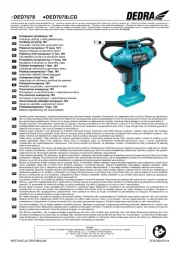
15 Juli 2025
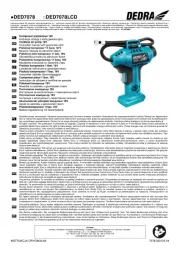
15 Juli 2025
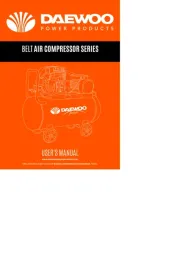
15 Juli 2025
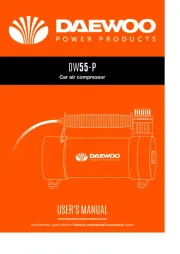
15 Juli 2025
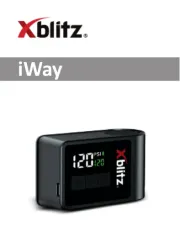
15 Juli 2025
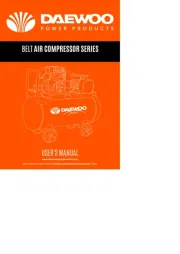
15 Juli 2025
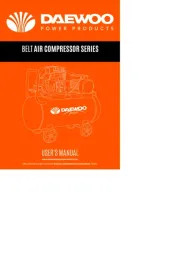
14 Juli 2025
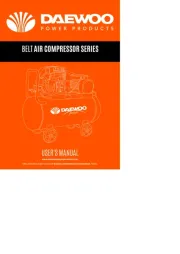
14 Juli 2025
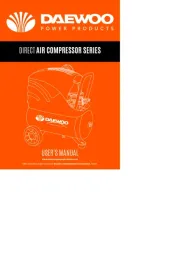
14 Juli 2025
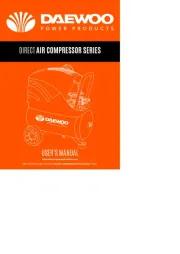
14 Juli 2025